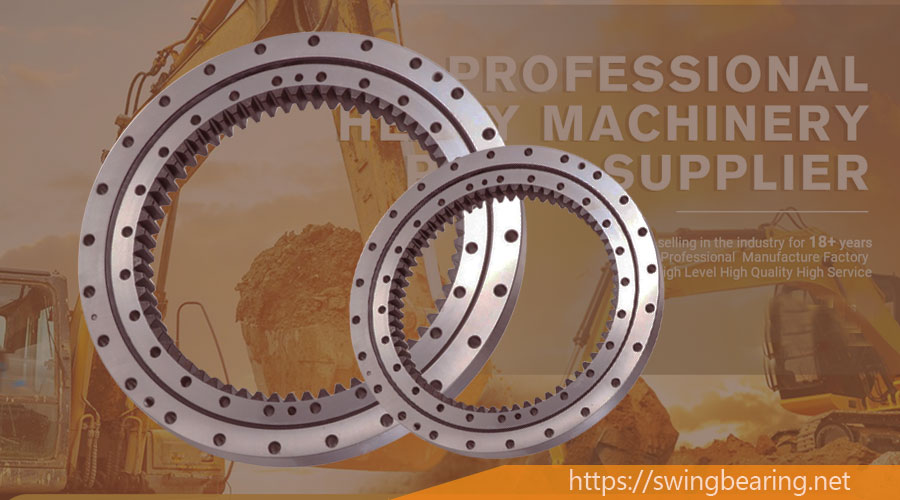
Slewing bearings are crucial components in heavy machinery, allowing for smooth and efficient rotational movement while supporting axial, radial, and overturning loads. However, excessive heat buildup in slewing bearings is a common issue that can compromise performance and lead to serious damage if left unaddressed. Understanding the root causes of heat generation and implementing appropriate corrective measures is vital for maintaining optimal bearing function and extending its lifespan. This article delves into the primary causes of heat in slewing bearings and offers practical solutions for addressing these issues.
Slewing bearings may experience heat buildup due to various factors, including improper installation, incorrect lubrication, and excessive shaft size. Below are the most frequent causes and how to resolve them.
One of the primary reasons for heat generation in slewing bearings is the use of an oversized shaft. When the shaft size is too large, it creates undue tightness in the bearing assembly, increasing friction and, consequently, heat.
Solution:
Ensure that the shaft diameter falls within the recommended tolerance levels specified by the manufacturer. The bearing should not be installed too tightly, as it needs to accommodate slight expansion during operation. Proper sizing will help reduce friction and prevent heat buildup.

The type and amount of lubricant applied to a slewing bearing are critical for its proper functioning. Excessive grease or an overly high oil level can cause churning within the bearing, leading to increased friction and heat.
Solution:
If the oil level is too high, excess grease may be expelled through the bearing seals. The lubricant level should be adjusted to just below the bearing box, allowing the oil to circulate efficiently without causing excessive drag. Additionally, selecting the correct type of grease for the specific operating conditions is essential. Consider consulting with a lubrication specialist to choose an appropriate lubricant that minimizes heat generation.
Conversely, insufficient lubrication can also lead to heat issues in slewing bearings. A low oil level or inadequate grease application results in poor lubrication, causing increased friction between the rolling elements and raceways.
Solution:
Maintain an adequate oil level, ideally just below the retainer, to ensure that the bearing is properly lubricated. Regularly inspect the lubricant levels and top up with the correct type of grease as needed to prevent dry running and reduce friction.
Improper installation, particularly misalignment between the inner and outer rings, can result in excessive friction and heat. If the inner ring or sealing ring is not aligned correctly, it can cause uneven load distribution, exacerbating wear and generating heat.
Solution:
Stop the machine and inspect the alignment of the slewing bearing. Ensure that the inner ring is securely clamped to the shaft and that the bearing rollers are properly aligned with the outer ring centerline. Use a calibrated torque wrench to tighten the clamping ring screws according to the manufacturer’s specifications.
Proactive measures can be taken to prevent heat-related problems in slewing bearings, enhancing their reliability and longevity.
Perform routine inspections to check for signs of excessive heat, such as discoloration, unusual noises, or increased vibration. Early detection of heat issues can help prevent catastrophic bearing failure.
Establish a consistent lubrication schedule based on the manufacturer’s recommendations. Regular lubrication not only minimizes friction but also helps dissipate heat effectively.
Investing in high-quality slewing bearings and compatible lubricants can reduce the likelihood of heat generation. Premium materials and precise manufacturing processes ensure better performance and longer service life.
| Cause | Effect | Solution |
|---|---|---|
| Oversized shaft | Increased friction and tightness | Ensure proper shaft tolerance |
| High oil level or excess grease | Churning, increased drag | Adjust lubricant level and select appropriate grease |
| Low oil level | Insufficient lubrication, dry running | Top up lubricant and maintain proper levels |
| Misalignment during installation | Uneven load distribution, friction | Realign inner and outer rings, check clamping force |
How often should slewing bearings be lubricated?
A: The lubrication frequency depends on the operating conditions. Generally, slewing bearings require lubrication every 100 to 500 operational hours. Consult the manufacturer’s guidelines for specific intervals.
What are the common signs of overheating in slewing bearings?
A: Signs of overheating include unusual noises during operation, increased vibration, and visible discoloration of the bearing surfaces. Monitoring these indicators can help detect heat issues early.
Can using the wrong type of grease cause heat buildup?
A: Yes, using a lubricant that is not suited for the specific application can result in poor lubrication, increased friction, and heat. It is essential to use a grease with the appropriate viscosity and thermal properties.
What should I do if I notice heat buildup in a slewing bearing during operation?
A: If you detect excessive heat, stop the machine immediately and inspect the bearing. Check for proper alignment, adequate lubrication, and any signs of wear or damage. Addressing these issues promptly can prevent further damage.
Managing heat in slewing bearings is essential for maintaining the performance and longevity of heavy machinery. By understanding the common causes of heat buildup and implementing effective solutions, operators can minimize downtime, reduce maintenance costs, and extend the life of their slewing bearings. Regular inspections, proper lubrication, and correct installation practices are key to ensuring optimal bearing performance.
Slewing bearings are the backbone of many industrial applications, and keeping them cool and well-maintained is crucial for the seamless operation of your equipment.